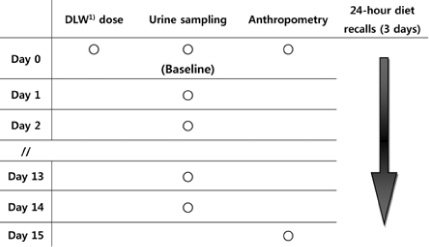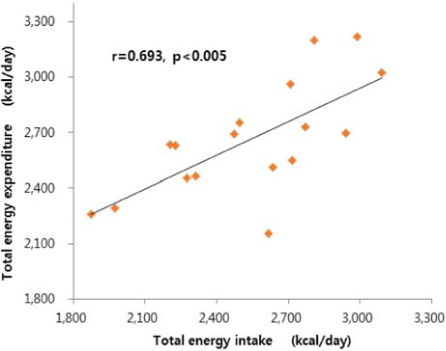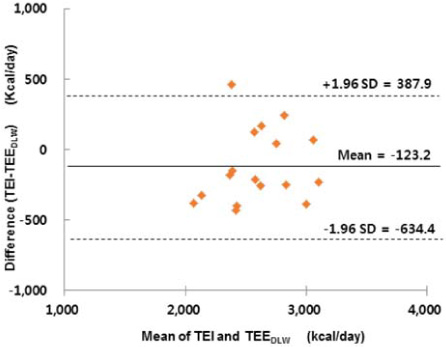Korean J Community Nutr.
2018 Dec;23(6):516-524. 10.5720/kjcn.2018.23.6.516.
Accuracy of 24-hour Diet Recalls for Estimating Energy Intake in Elderly Men using the Doubly Labeled Water Method
- Affiliations
-
- 1Department of Food and Nutrition, Gangneung-Wonju National University, Gangneung, Korea, Student.
- 2Department of Food and Nutrition, Gangneung-Wonju National University, Gangneung, Korea, Professor. ekkim@gwnu.ac.kr
- KMID: 2431482
- DOI: http://doi.org/10.5720/kjcn.2018.23.6.516
Abstract
OBJECTIVES
This study assessed the accuracy of the 24-hour diet recall method for estimating the energy intake of elderly men using the doubly labeled water as a reference method.
METHODS
Seventeen subjects (mean age 72.5 ± 3.9 years), who maintained the same body weight during the two weeks study period, were included in this study. Three 24-hour diet recalls (two weekdays and one weekend) were obtained over a 14 day period to estimate the mean energy intake. The total energy expenditure was measured over the same 14 days using the doubly labeled water method. The total energy intake and total energy expenditure were compared by paired t-test.
RESULTS
The total energy intake from the 24-hour diet recalls method was 2536.7 ± 350.6 kcal/day, and the total energy expenditure from the doubly labeled water method was 2659.8 ± 306.8 kcal/day. The total energy intake was slightly under-reported by −123.2 ± 260.8 kcal/day (−4.4%). On the other hand, no significant difference was observed between the total energy intake and total energy expenditure of the subjects (p=0.069). The percentage of accurate predictions was 64.7%. The correlation between the total energy intake and total energy expenditure was statistically significant (r=0.697, p < 0.005).
CONCLUSIONS
The present study supports the use of the 24-hour diet recall method to estimate the mean energy intake in elderly men group. More studies are needed to assess the validity of 24-hour diet recall method in other population groups, including elderly women, adults and children.
MeSH Terms
Figure
Cited by 2 articles
-
A short education session increases the accuracy of estimated food records in young Korean women during a controlled-feeding study
Seunghee Kim, Bora Lee, Clara Yongjoo Park
Nutr Res Pract. 2021;15(5):613-627. doi: 10.4162/nrp.2021.15.5.613.Comparison of total energy intakes estimated by 24-hour diet recall with total energy expenditure measured by the doubly labeled water method in adults
Eun-Kyung Kim, Justice Otoo Fenyi, Jae-Hee Kim, Myung-Hee Kim, Seo-Eun Yean, Kye-Wol Park, Kyungwon Oh, Sungha Yoon, Kazuko Ishikawa-Takata, Jonghoon Park, Jung-Hyun Kim, Jin-Sook Yoon
Nutr Res Pract. 2022;16(5):646-657. doi: 10.4162/nrp.2022.16.5.646.
Reference
-
1. Statistics Korea. KOSTAT statistics plus [Internet]. Statistics Korea;2018. cited 2018 Nov 6. Available from: http://kostat.go.kr/.2. Statistics Korea. Statistics report about senior [Internet]. Statistics Korea;2018. cited 2018 Nov 6. Available from: http://kostat.go.kr/.3. Kim HR. Nutrition transition and shiting diet linked noncommunicable disease and policy issues. Health Welf Policy Forum. 2013; 198:27–37.4. Ma Y, Hebert J, Ebbeling C, Ockene I. International aspects of coronary heart disease epidemiology. In : Becker RC, Alpert JS, editors. Cardiovascular medicine-practice and management. London: Arnold;2001. p. 3–20.5. Liu S. Whole-grain foods, dietary fiber, and type 2 diabetes: searching for a kernel of truth. Am J Clin Nutr. 2003; 77(3):527–529.
Article6. World Cancer Research Fund. Food, nutrition, physical activity and the prevention of cancer: a global perspective [Internet]. World Cancer Research Fund/American Institute for Cancer Research;2007. cited 2018 Nov 7. Available from: http://www.dietandcancerreport.org/.7. Michels KB. Nutritional epidemiology-past, present, future. Int J Epidemiol. 2003; 32(4):486–488.
Article8. Baik I, Cho NH, Kim SH, Shin C. Dietary information improves cardiovascular disease risk prediction models. Eur J Clin Nutr. 2013; 67(1):25–30.
Article9. Streppel MT, Sluik D, van Yperen JF, Geelen A, Hofman A, Franco OH. Nutrient-rich foods, cardiovascular diseases and all-cause mortality: the Rotterdam study. Eur J Clin Nutr. 2014; 68(6):741–747.
Article10. Ma Y, Olendzki BC, Pagoto SL, Hurley TG, Magner RP, Ockene IS. Number of 24-hour diet recalls needed to estimate energy intake. Ann Epidemiol. 2009; 19(8):553–559.
Article11. Hill RJ, Davies PS. The validity of self-reported energy intake as determined using the doubly labelled water technique. Br J Nutr. 2001; 85(4):415–430.
Article12. The Korean Society of Nutritional Epidemiology. Nutritional epidemiology (translated version). 3th ed. Seoul: Kyomunsa;2013. USA original written by Willett W.13. Lee MS, Woo MK, Kim SA, Oh SI, Kwak CS. Reproducibility of nutrient intake estimated by three-day 24-hour dietary recall of middle-aged subjects for 6 month intervals. Korean J Community Nutr. 2003; 8(4):603–609.14. Ministry of Health and Welfare of Korea, Korea Centers for Disease Control and Prevention. Korea health statistics 2016: Korea national health and nutrition examination survey (KNHANES VII-1). Ministry of Health and Welfare of Korea;2018. 01. Report No. 117002.15. Brio G, Hulshof KF, Ovesen L, Amorim Cruz JA. Selection of methodology to assess food intake. Eur J Clin Nutr. 2002; 56:Suppl 2. 25–32.
Article16. Salvador Castell G, Serra-Majem L, Ribas-Barba L. What and how much do we eat? 24-hour dietary recall method. Nutr Hosp. 2015; 31(3):46–48.17. Bathalon GP, Tucker KL, Hays NP, Vinken AG, Greenberg AS, McCrory MA. Psychological measures of eating behavior and the accuracy of 3 common dietary assessment methods in healthy postmenopausal women. Am J Clin Nutr. 2000; 71(3):739–745.
Article18. Sawaya AL, Tucker K, Tsay R, Willett W, Saltzman E, Dallal GE. Evaluation of four methods for determining energy intake in young and older women: comparison with doubly labeled water measurements of total energy expenditure. Am J Clin Nutr. 1996; 63(4):491–499.
Article19. Hill JO, Wyatt HR, Peters JC. Energy balance and obesity. Circulation. 2012; 126(1):126–132.
Article20. Schoeller DA. How accurate is self-reported dietary energy intake? Nutr Rev. 1990; 48(10):373–379.
Article21. Johnson RK, Driscoll P, Goran MI. Comparison of multiple-pass 24-hour recall estimates of energy intake with total energy expenditure determined by the doubly labeled water method in young children. J Am Diet Assoc. 1996; 96(11):1140–1144.
Article22. Johnson RK, Soultanakis RP, Matthews DE. Literacy and body fatness are associated with underreporting of energy intake in US low-income women using the multiple-pass 24-hour recall: a doubly labeled water study. J Am Diet Assoc. 1998; 98(10):1136–1140.23. Subar AF, Kipnis V, Troiano RP, Midthune D, Schoeller DA, Bingham S. Using intake biomarkers to evaluate the extent of dietary misreporting in a large sample of adults: the open study. Am J Epidemiol. 2003; 158(1):1–13.
Article24. Lee SJ, Kim HR. Total energy expenditure of professional soccer players measured by the doubly labeled water method. J Exerc Nutr Biochem. 2003; 7(3):214–246.25. Kim EK, Ndahimana D, Ishikawa-Takata K, Lee S, Kim H, Lim K. Validation of dietary reference intakes for predicting energy requirements in elementary school-age children. Nutr Res Pract. 2018; 12(4):336–341.
Article26. Park J, Kazuko IT, Kim E, Kim J, Yoon J. Estimating free-living human energy expenditure: practical aspects of the doubly labeled water method and its applications. Nutr Res Pract. 2014; 8(3):241–248.
Article27. Lee YN. Development of food and nutrient database: food portion/weight database. Korea Health Industry Development Institute;2007. 12. Report No. 2007-114.28. Kim EK, Kim JH, Kim MH, Ndahimana D, Yean SE, Yoon JS. Validation of dietary reference intake equations for estimating energy requirements in Korean adults by using the doubly labeled water method. Nutr Res Pract. 2017; 11(4):300–306.
Article29. Bhutani S, Racine N, Shriver T, Schoeller DA. Special considerations for measuring energy expenditure with doubly labeled water under atypical conditions. J Obes Weight Loss Ther. 2015; 5:Suppl 5. 1–20.
Article30. Black AE, Prentice AM, Coward WA. Use of food quotients to predict respiratory quotients for the doubly-labelled water method of measuring energy expenditure. Hum Nutr Clin Nutr. 1986; 40(5):381–391.31. Weir JB. New methods for calculating metabolic rate with special reference to protein metabolism. J Physiol. 1949; 109(1-2):1–9.
Article32. Barnston AG. Correspondence among the correlation, RMSE, and Heidke forecast verification measures; refinement of the Heidke score. Weather Forecast. 1992; 7(4):699–709.
Article33. Weijs PJ. Validity of predictive equations for resting energy expenditure in US and Dutch overweight and obese class I and II adults aged 18-65 y. Am J Clin Nutr. 2008; 88(4):959–970.
Article34. Frankenfield D, Roth-Yousey L, Compher C. Comparison of predictive equations for resting metabolic rate in healthy nonobese and obese adults: a systematic review. J Am Diet Assoc. 2005; 105(5):775–789.
Article35. Marra M, Montagnese C, Sammarco R, Amato V, Della Valle E, Franzese A. Accuracy of predictive equations for estimating resting energy expenditure in obese adolescents. J Pediatr. 2015; 166(6):1390–1396.
Article36. Johnson RK, Goran MI, Poehlman ET. Correlates of over- and underreporting of energy intake in healthy older men and women. Am J Clin Nutr. 1994; 59(6):1286–1290.
Article37. Rothenberg E, Bosaeus I, Lernfelt B, Landahl S, Steen B. Energy intake and expenditure: validation of a diet history by heart rate monitoring, activity diary and doubly labeled water. Eur J Clin Nutr. 1998; 52(11):832–838.
Article38. Riumallo JA, Schoeller D, Barrera G, Gattas V, Uauy R. Energy expenditure in underweight free-living adults: impact of energy supplementation as determined by doubly labeled water and indirect calorimetry. Am J Clin Nutr. 1989; 49(2):239–246.
Article39. Black AE, Bingham SA, Johansson G, Coward WA. Validation of dietary intakes of protein and energy against 24 hour urinary n and DLW energy expenditure in middle-aged women, retired men and post-obese subjects: comparisons with validation against presumed energy requirements. Eur J Clin Nutr. 1997; 51(6):405–413.
Article40. Tomoyasu NJ, Toth MJ, Poehlman ET. Misreporting of total energy intake in older men and women. J Am Geriatr Soc. 1999; 47(6):710–715.
Article41. Goran MI, Poehlman ET. Total energy expenditure and energy requirements in healthy elderly persons. Metabolism. 1992; 41(7):744–753.
Article42. Cho YE, Lee SL, Cho EH, Ria-Ann LL, Kwak EH, Kim YA. Comparison of nutrient intakes of Korean elderly people living in rural area between 24-hour recall and food frequency method. J Korean Soc Food Sci Nutr. 2006; 35(6):698–707.43. Gemming L, Rush E, Maddison R, Doherty A, Gant N, Utter J. Wearable cameras can reduce dietary under-reporting: doubly labelled water validation of a camera-assisted 24 h recall. Br J Nutr. 2015; 113(2):284–291.44. Gemming L, Doherty A, Kelly P, Utter J, Mhurchu CN. Feasibility of a sensecam-assisted 24-h recall to reduce under-reporting of energy intake. Eur J Clin Nutr. 2013; 67(10):1095–1099.
Article
- Full Text Links
- Actions
-
Cited
- CITED
-
- Close
- Share
- Similar articles
-
- Accuracy of the 24-hour diet recall method to determine energy intake in elderly women compared with the doubly labeled water method
- Comparison of total energy intakes estimated by 24-hour diet recall with total energy expenditure measured by the doubly labeled water method in adults
- Estimating free-living human energy expenditure: Practical aspects of the doubly labeled water method and its applications
- Validation of dietary reference intake equations for estimating energy requirements in Korean adults by using the doubly labeled water method
- A narrative review on the application of doubly labeled water method for estimating energy requirement for Koreans




